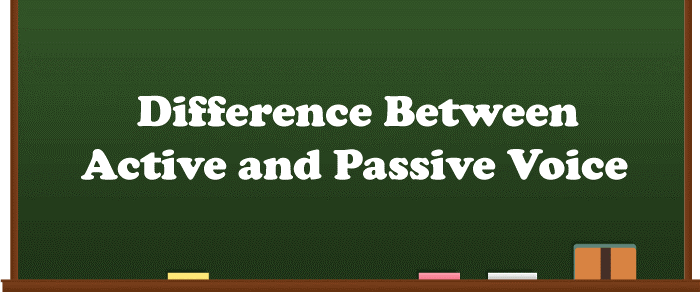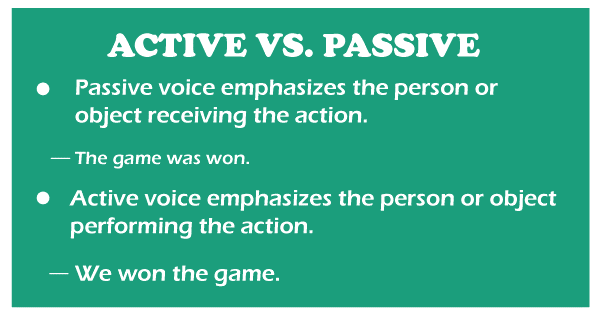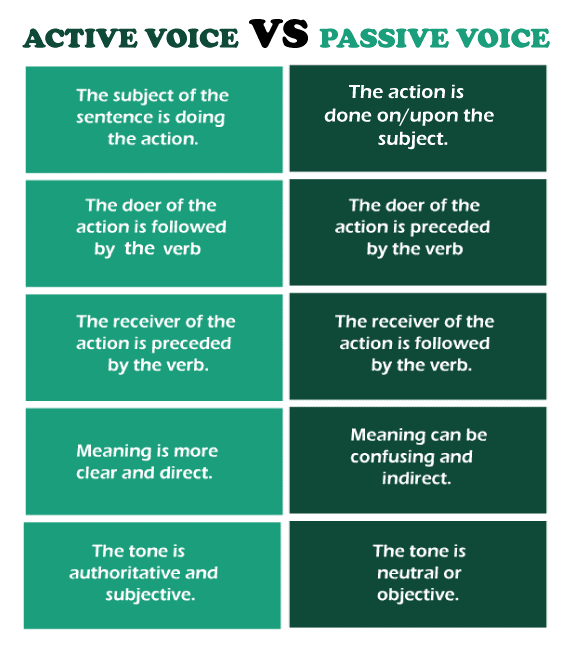Difference Between Active and Passive VoiceIn English Grammar, active and passive voice is an essential concept. The voice in grammar denotes whether the verb's action is done by the subject or done on the subject. 
In English, there are two types of voices: active and passive. If the subject is performing the activity then the statement is in active voice. If the action takes place on the subject, the sentence is deemed passive. This is the primary difference between active and passive voice. What Exactly Is Active Voice?If the subject performs the action, the statement is in active voice. Most of the phrase constructs we come across in everyday life are in active voice. Active voice sentences are shorter and more direct than passive voice statements. Thus, these are less puzzling and clear. To identify an active sentence, first, identify the subject and then inquire whether the subject is executing the action. In an active voice statement, the doer (person or object executing the action) comes first, followed by the receiver of the action. Some instances of active voice sentences are shown below.
It's worth noting that linking verbs and intransitive verbs are more common in the active voice. It is because, contrary to passive voice statements, active voice sentences do not necessarily require objects. 
What Exactly Is Passive Voice?The passive voice is the inverse of the active voice. In this case, the action is carried out on the subject instead of by the subject. The receiver of the act comes first in the sentence, and the doer of the act comes after the verb. As an example, The pupils were instructed by the lecturer . Here in this sentence pupil is the receiver and the lecturer is the doer . It is vital to notice that unless a statement includes a direct object, it cannot be converted into a passive voice. Because active verbs undergo a significant change in passive voice, passive sentences are generally lengthier than active sentences. Passive sentences are also used to emphasize the verb and the recipient of the action. They are less straightforward and use balanced or objective language. The thing or person doing the activity may sometimes be excluded from the sentence. Some instances of passive voice sentences are shown below.
Now let us have a look at some of the differences between active and passive voice. Primary Distinctions Between Active and Passive VoiceLet us have a look at the Difference Between Active and Passive Voice Use Active Voice: The action is being performed by the sentence's subject . Passive Voice: The action is performed on/on the subject in the passive voice . Performer of the actionActive Voice: The someone who does the action is followed by the verb in active voice . Passive Voice: The verb precedes the doer of the action in passive voice . Action's receiverActive Voice: The verb precedes the recipient of the action in active voice . Passive Voice: The verb is accompanied by the recipient of the action in passive voice . ClarityActive Voice: Meaning is more direct and precise . Passive Voice: Meaning can be ambiguous and oblique . ToneActive Voice: The tonality of the active voice is powerful and subjective . Passive Voice: The tonality is neutral or objective in passive voice . Direct ObjectsActive Voice: Sentences without direct objects can be stated in active voice . Passive Voice: Passive voice cannot be employed in sentences that do not include direct objects . PositionThe subject comes first because it is the one that takes responsibility for the activity . The objects on which the actions take place tend to appear first, followed by the actor at the conclusion . Instances of Active and Passive VoiceActive: He is playing football . Passive: Football is being played by him . Active: He sent a proforma to the Project Manager . Passive: A proforma was sent by him to the Project Manager. Active: Kids are enjoying the celebration . Passive: The celebration is being enjoyed by the kids . Usage of Active and Passive VoiceWhen Should You Utilize Active Voice ?Strong, concise sentencesExample No. 1 Active: This analysis of recycling criteria in the Europe, Canada, and the United States shows that the recycling ability of a nation can vary greatly based on which standard is used . Passive: It is illustrated in this analysis of recycling criteria in Europe, Canada, and the United States that a nation's recycling ability can vary dramatically based on which standard is used . In this scenario, the active voice statement is the more powerful and preferable option. It is more clear, simpler, and crisper. It expresses precisely what the writers provided in their article. The passive sentence is very wordy and awkward. Example No. 2 Active voice: "The puppy rolled the football. " Passive Voice: The football was rolled by the puppy . The active voice is preferable in this extremely basic statement. It is more brief (shorter), direct, and powerful. In this situation, the passive voice is very wordy and clumsy . However, there are numerous instances where we are unable or do not want to highlight the performer, especially if there is a sense of mystery involved: An example "My phone was stolen on Saturday evening," This is a passive sentence . In this scenario, the speaker may or may not know who robbed her phone, so the passive voice is completely appropriate . "Someone stole my phone on Saturday evening" is an active voice option. However, in this scenario, the speaker is likely to stress the action instead of the culprit. She wishes to stress that something negative occurred to her . Highlight The SubjectActive: Chakraborty suggested the strategies and guidelines by which each procedure in product fabrication could be evaluated . Passive: The strategies and guidelines by which each procedure in product fabrication could be evaluated were suggested by Chakraborty . Unlike the other examples, the active voice is the superior choice in this circumstance. A paper's literature review section frequently aims to identify the most significant contributions to the subject, which makes performers crucial. In the above instances, the active voice statements are much more clear and crisper in comparison to passive. 
When Should You Utilize the Passive Voice?Example 1: Highlighting the Object Passive: The surveys were performed by two individuals who had no connection with Brooklyn . Active: The surveys were performed by two people who had no connection to Brooklyn [or by two individuals who had no connection to Brooklyn] . Both sentences convey the same concept. In this instance, the writers aim to highlight the conversations - and how they were performed - as an important component of their study process. As a result, the passive voice is proper, yet the active voice is not inappropriate. Example No. 2 Passive: This work was completed by the university of the Literature . Active: The university of Literature completed this work . Once again, the university stressed that their work was approved. This is critical information, perhaps even more significant than the institution that approved it. As a result, the passive voice is justifiable. Avoiding The Use of The First and Third PersonPassive: A GIS application was employed for the evaluation of the geography of the area . Active option 1: We used a GIS application for geographical analysis . Active option 2: The team used the GIS application for the evaluation of geography . The active options in this scenario may be troublesome for a variety of reasons. Although the first choice is grammatically correct, some authors and publications prefer to avoid using the first person. Using the passive voice is an easy approach to avoid having to decide whether or not to use the sometimes-controversial term "we." Active option 2 is grammatically right but sounds odd because it uses the third person ("the team"). As in Instance 1, the writers of this essay highlight parts of their process, one of which is their software selection. As a result, the passive voice statement is appropriate. Auxiliary And Passive VerbsSomething stands out about the passive instances above: Both utilize the verb "to be" in the past tense ("was used," "was completed"). Since it aids in completing the sentence (you can't say "My automobile was taken on Sunday night"), this is known as a "helping" or "auxiliary" verb. Because these verbs are not required in active sentence forms, many people believe active statements are more powerful and precise. As a result, the active vs. passive voice you utilize may differ depending on which portion of your essay you are writing. Each part has a different objective and emphasis. Therefore you should modify your usage of active vs. passive voice appropriately. If you wish to emphasize the contributions, results, or achievements of your research, utilize the active voice in your conclusions. ConclusionIn conclusion, both active and passive voices are suitable in scientific/academic write-ups. Evaluating what you are attempting to emphasize in a specific sentence or portion of your article is critical. It is simple to use the passive voice in academic work, and it is often the best option. If you're not sure, try rephrasing the sentence in the active voice and seeing if it affects the meaning of the sentence or merely makes your work simpler or more precise.
Next TopicEnglish Sentence
|
 For Videos Join Our Youtube Channel: Join Now
For Videos Join Our Youtube Channel: Join Now
Feedback
- Send your Feedback to [email protected]
Help Others, Please Share









